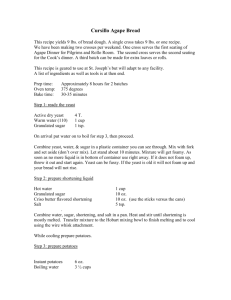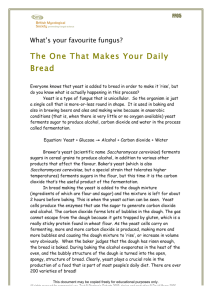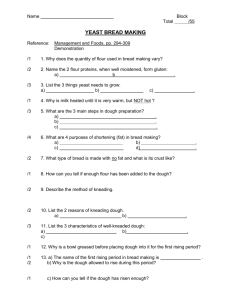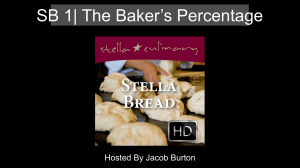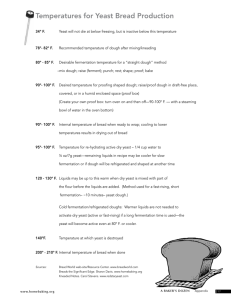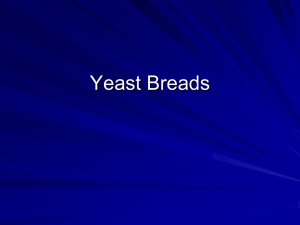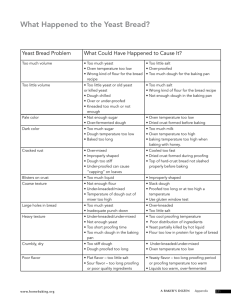Creative Breads - Red Star Yeast
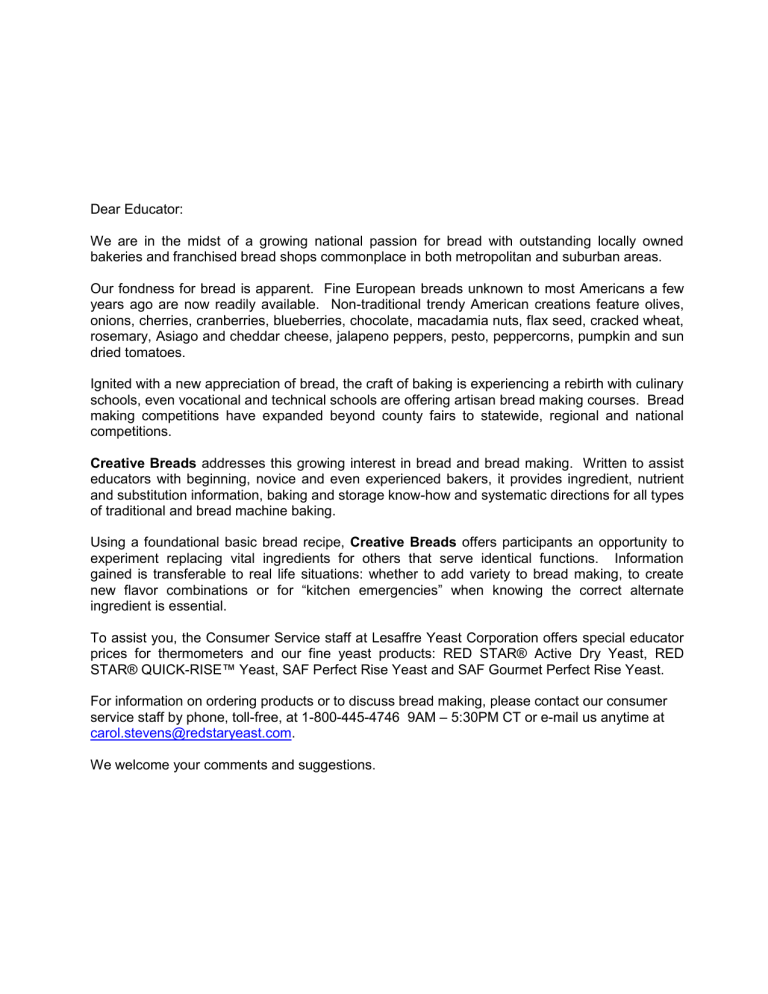
Dear Educator:
We are in the midst of a growing national passion for bread with outstanding locally owned bakeries and franchised bread shops commonplace in both metropolitan and suburban areas.
Our fondness for bread is apparent. Fine European breads unknown to most Americans a few years ago are now readily available. Non-traditional trendy American creations feature olives, onions, cherries, cranberries, blueberries, chocolate, macadamia nuts, flax seed, cracked wheat, rosemary, Asiago and cheddar cheese, jalapeno peppers, pesto, peppercorns, pumpkin and sun dried tomatoes.
Ignited with a new appreciation of bread, the craft of baking is experiencing a rebirth with culinary schools, even vocational and technical schools are offering artisan bread making courses. Bread making competitions have expanded beyond county fairs to statewide, regional and national competitions.
Creative Breads addresses this growing interest in bread and bread making. Written to assist educators with beginning, novice and even experienced bakers, it provides ingredient, nutrient and substitution information, baking and storage know-how and systematic directions for all types of traditional and bread machine baking.
Using a foundational basic bread recipe, Creative Breads offers participants an opportunity to experiment replacing vital ingredients for others that serve identical functions. Information gained is transferable to real life situations: whether to add variety to bread making, to create new flavor co mbinations or for “kitchen emergencies” when knowing the correct alternate ingredient is essential.
To assist you, the Consumer Service staff at Lesaffre Yeast Corporation offers special educator prices for thermometers and our fine yeast products: RED STAR® Active Dry Yeast, RED
STAR® QUICK-RISE ™ Yeast, SAF Perfect Rise Yeast and SAF Gourmet Perfect Rise Yeast.
For information on ordering products or to discuss bread making, please contact our consumer service staff by phone, toll-free, at 1-800-445-4746 9AM – 5:30PM CT or e-mail us anytime at carol.stevens@redstaryeast.com
.
We welcome your comments and suggestions.
CREATIVE BREADS
An Educator’s Guide to Ingredient Substitution in Yeast Breads
LEARNING OBJECTIVES
Achieve ability to make informed decisions on appropriate substitutions
Identify function of ingredients in a dough system
Recognize interdependence of ingredients in a yeast dough
Demonstrate bread making skill
Integrate knowledge of bread dough ingredients with bread making skill
Demonstrate ability to create a quality product
PERFORMANCE TASK
Apply knowledge of ingredients to create a bread recipe
Demonstrate bread making skill
PROGRAM GOALS
Demonstrate knowledge of bread ingredient substitution
Acquire knowledge of ingredients’ functions
Apply knowledge of bread making
Gain skill in bread making traditionally and with a bread machine
EXPERIENTIAL LEARNING TEACHING STRATEGY
Utilize ingredient substitutions in a basic recipe
Integrate knowledge and bread making skill
Process information: analyze and reflect on bread making experience
Share results and observations
Generalize to connect with everyday baking experiences
ASSESSMENT DEVICE
Improving Breads information
APPLICATION
Creating new breads
Emergency substitutions
Dietary restrictions
Everyday cooking
OTHER RESOURCES
Breads for Youth Groups, Red Star Yeast
Home Baking Association website: www.homebaking.org/foreducatores/educatornotes
RED STAR Yeast website: www.redstaryeast.com
The Science of Yeast, Red Star Yeast
Basic Bread
Active dry yeast
Bread flour
Sugar
Salt
Vegetable oil
Water
GROCERY LISTS
Substitutions
Instant yeast
Cake yeast
All-purpose flour
Spelt flour
Whole wheat flour
Brown sugar
Confectioners’ sugar
Honey
Molasses
Salt substitute (KCl+NaCl)
Sea salt
Butter
Olive oil
Canola oil
Shortening
Potato water
Yogurt
Milk
Non-fat dry milk
Buttermilk
Powdered buttermilk
Evaporated milk
Pumpkin puree
Eggs
Optional Additions
Dried blueberries
Dried cherries
Dried cranberries
Dried vegetable pieces
Dried onions
Raisins
Sun-dried tomatoes
Grated Swiss cheese
Grated cheddar cheese
Almonds
Walnuts
Pecans
Spanish olives
Ripe black olives
Kalamata olives
Jalapeno peppers
Cracked wheat
Flax seeds
Sesame seed
Caraway seeds
Peppercorns
Dill weed
Dried herbs
Fresh herbs
Materials and Equipment List
All methods
Baking pans
Bread knife
Cooling rack
Dry ingredient measuring cups
Liquid ingredient measuring cups
Measuring spoons
Microwave oven or stove
Oven
Oven mitts or hot pads
Rubber spatula
Sturdy work surface
Thermometer*
Hand method
Large bowl
Large sturdy mixing spoon
Mixer methods
Hand mixer
Stand mixer
Medium bowl Food processor
Bread machine method
Optional
Bread machine Aprons
Freezer
Plastic wrap
Mixing bowl
Medium bowl
Refrigerator
Resealable plastic food storage bags
Rolling pin
Timer
* Thermometers especially designed for yeast bread baking are available for educators from RED STAR® Yeast, P.O. Box 737, Milwaukee WI 53201
Cost is 5 / $1.00
Function of Bread Ingredients
Yeast
is a single-celled living plant organism that is a rich source of B vitamins. The yeast used in bread making is saccharomyces cerevisiae (sack-rah-my-sees sar-ah-vis-see-ay). It is able to convert fermentable carbohydrates as maltose, glucose, fructose and sucrose into carbon dioxide and alcohol.
In bread dough, yeast provides leavening as it ferments flour, sugar, molasses or honey. Tiny carbon dioxide gas bubbles are trapped within elastic dough forming a honeycomb-like structure that causes dough to stretch and expand-to “rise.” During this fermentation process, heat is generated and flavors produced.
Yeast activity is influenced by storage practices, amount and pH of liquid, food supply and temperature. Of these points, the most important is temperature. At 86
F, yeast doubles its numbers almost every two hours. When liquid, sugar and warmth (105
-115
F) are added, yeast germinates and reproduces even more rapidly in a budding process.
Types of Yeast Used in Bread Making
Fresh Yeast
is a highly perishable yeast product with mere 8 weeks shelf life from the time of manufacture. It needs constant refrigeration (38
F to 45
F) and is available in limited markets where demand warrants its distribution.
Fresh yeast is sometimes referred to as “Compressed Yeast or “Wet Yeast.” During the manufacturing process, the product is compressed leaving 65% water. Packaged in small blocks for the home baker, this form of yeast is a lso referred to as “cakes.” A cake, however, is not a standard of measurement and yeast blocks sizes have changed through the years. For traditional baking, 1-ounce fresh yeast will raise approximately 6 cups flour; in a bread machine, 2/3 ounce (0.6 ounce) of fresh yeast will raise 3 to 3 ½ cups flour.
Other than when used in a bread machine, fresh yeast is usually dissolved in lukewarm
(80
F) water before using.
Active Dry Yeast
has gone through a series of drying chambers to lower moisture content to about 8%. It is more stable than fresh yeast, nevertheless, it too is perishable.
Factory sealed packages may be kept at room temperature; once opened, however, the yeast package must be closed tightly and refrigerated or frozen to retain activity.
For traditional baking, active dry yeast may be rehydrated in very warm (110
-115
F) water or may be mixed in with dry ingredients. In the la tter method, termed “mixer method,” liquids are heated to 130
F, then added to a yeast-flour mixture. In this method, fragile yeast cells are protected with an “overcoat” of dry ingredients. The extra warmth of this method produces faster fermentation. For bread machine baking, 80
F liquid temperature is recommended.
RED STAR® Active Dry Yeast and SAF Traditional Active Dry Perfect Rise Yeast are packaged in 4-ounce jars and in 3-packet strips. A packet contains ¼ ounce (7 g), approximately 2 ¼ teaspoons. This amount is sufficient to leaven up to 4 cups flour for traditional baking. For bread machine baking ¾ teaspoon active dry yeast is recommended for each cup of flour, or 2 1/4 teaspoons for 3 cups flour.
Instant Yeast
is a special strain of high activity, fast-acting yeast that has gone through a series of drying chambers to lower the moisture content to about 8%. It is more stable than fresh yeast; nevertheless, it too is perishable. Factory sealed packages may be kept at room temperature; once opened, however, the yeast package must be closed tightly and refrigerated or frozen to retain activity.
Although this fast acting yeast does not eliminate a first rise time, it will shorten rising time as much as 50%. When used in traditional baking, 2¼ teaspoons instant yeast is recommended for up to 4 cups flour. When used in a bread machine, the recommended amount is ½ teaspoon for each cup flour or 1 1/2 teaspoons for 3 cups flour. For onehour bread machine cycles, however, yeast amounts must be increased to double or more.
RED STAR® and SAF instant, fast-acting yeast is known as Bread Machine Yeast when packaged in 4-ounce jars and as Quick-Rise Yeast ; and SAF Gourmet Perfect
Rise Yeast when packaged in 3-packet strips
Flour
is the product obtained by grinding, then sifting a grain. Grinding grain for food has been traced to the Far East, Egypt and Rome. Grain was ground with rocks as early as 6700 B.C., The use of grain-grinding water mills began about 85 B.C. in Asia Minor. An upgrade, windmills, began to be used between 1180 and 1190 in Syria, France and England.
The grain of choice for centuries has been wheat; in fact, the term ”flour” is used interchangeably with wheat flour today. Wheat differs from other grains as it contains a high percentage of glutenforming protein complex that is insoluble in water. Mixed with liquid, a rubbery mass forms creating an elastic network that provides structure to dough as it stretches.
Wheat is a storehouse of nutrients considered essential in the human diet. It is an excellent source of complex carbohydrates, deriving at least 80 percent of its calories from carbohydrates.
Depending on the flour type, the percentage of calories from protein ranges from 9 to 15 percent.
Calories from fat are never more than 3 percent. Wheat flour contains 3 grams (cake flour) to 15 grams (whole wheat flour) dietary fiber for each 1-cup serving. Wheat contains B-vitamins, calcium, folic acid, iron, magnesium, phosphorus, potassium, zinc and other trace elements and minimal amounts of sodium.
There are six different classes of wheat: Hard Red Winter, Hard Red Spring, Soft Red Winter, Hard
White, Soft White and Durum. The end products are determined by the wheat's characteristics, especially protein and gluten content. Hard wheat has more gluten producing protein and is especially suited to bread making.
Types of Wheat Flour Used in Bread Making
All-purpose flour
is a blend of hard and soft wheat white flours. It is milled from the endosperm, the white, protein-rich (7.5 to 11%) middle portion of a wheat kernel. Other nutrients are carbohydrates, iron and many B-complex vitamins as riboflavin, niacin and thiamine.
All-purpose flour is enriched and may be bleached or unbleached. It has a low liquid absorption quality and a short mixing time tolerance. Different brands vary in performance.
As its name states, all-purpose flour fills a wide range of home baking needs from breads and biscuits to pies and cookies. Breads made with all-purpose flour do not raise as high those made with bread flour.
Bread flour
is milled from the endosperm of hard wheat varieties. Hard wheat has a greater percentage of gluten, therefore bread flour has a greater gluten strength than allpurpose flour. Protein content of bread flour varies from 12 to 14 percent. In bread dough, a strong gluten network is of utmost importance for the retention of gases produced during fermentation.
Bread flour has a high liquid absorption quality and a long mixing tolerance. Commercial bakers and home bakers using stand mixers, food processors or bread machines favor bread flour as it can withstand treatment from machinery.
Whole wheat, stone-ground and graham
flours are all milled from the entire wheat kernel containing the endosperm, germ and bran. Wheat germ is the embryo portion of the wheat kernel, rich with B-complex vitamins and nutrients and oil. The oil content of whole grain flour makes them more perishable than white flours, requiring refrigeration or freezing to preserve the natural oils and prevent rancidity. Bran is the kernel's outer insoluble fiber covering, providing fiber needed for our body’s digestive system. In a dough system, bran reduces gluten development resulting in heavier, denser loafs than those made with white flour.
Whole grain wheat flours can be used interchangeably in bread making. They differ in coarseness, though minimally in nutrient value.
Spelt
is often tolerated by individuals who are wheat-sensitive. Available as white spelt and whole grain spelt, this ancient variety of wheat contains a high degree of protein-producing gluten needed to make good bread. Recipes using this flour need to be adjusted, however, as spelt does not absorb liquids as well as wheat.
Other Grains
traditionally used in bread making are barley, corn, millet, oats and rye. Breads made with these low gluten-producing grains are usually mixed with white or whole wheat flour.
Liquids
dissolve yeast, hydrate flour to form gluten to make an elastic, workable dough and provide a moist environment for yeast to grow and multiply. Liquids represent approximately 40% of total dough volume. Water and milk are the most common liquids used in bread making.
Yeast thrives in a slightly acidic environment with an optimum pH range at 4.5 - 5.5. Milk products fit within that range, giving bread a softer crumb and crust than one made with water. Cultured milk products as buttermilk, yogurt, and sour cream produce moist breads with a flavor similar to sourdough bread. Acidic fruit and vegetable juices and purees can be used successfully in limited amounts in bread making. Berries, brussels spouts, grapefruit, kiwi, lemons, lentils, oranges, pineapple, strawberries and tomatoes are acidic.
Alkaline liquids tend to neutralize the normal acidly developed during yeast fermentation.
Therefore choosing purees and juices from alkaline fruit and vegetables must be chosen judiciously. Apples, apricots, asparagus, beans, beets, broccoli, cauliflower, cherries, grapes, onions, peaches and prunes are alkaline.
Excessive hardness and softness of water also greatly affect bread dough. Water of medium hardness (120 - 180 ppm) the most suitable. Hard water is undesirable as it retards fermentation by tightening the gluten structure too much. Soft water lacks gluten-strengthening minerals and tends to produce dough that is soft and sticky.
Fat
tenderizes bread and crust, retards staling by providing moisture and acts as a lubricant on gluten strands enabling dough to stretch and expand freely making dough easier to handle and shape. Fat is a generic term for vegetable oil, butter, margarine, shortening, lard and combinations of these. Although not necessary in bread, up to 5 percent fat is recommended for breads with a minimum of 0.7 to 1 percent fat needed for good slicing. White pan bread has between 1.5 and 3 percent fat. Traditional French bread has no fat.
Fat substitutes, as purees of applesauce and prune, produce heavy, moist bread. If substituting with one of these products, use half the usual amount of fat.
Sugar
provides food for the yeast. To maintain yeast activity, 3 to 3.5 percent fermentable sugar is required. In bread, sugar usage levels range from 0 to 15 percent. Sweet breads, an entirely different category of breads, have more than 15 percent sugar. Nevertheless, added sugar is not necessary for fermentation as this food supply can come from the conversion of starches (complex carbohydrates) to simple sugars in the fermentation process, or from a combination of both. The best known no-added-sugar bread is traditional French bread.
Sugar that is not required to maintain yeast activity, that remains unfermented, is termed residual sugar. When residual sugar levels are higher, crust color is darker, taste is sweeter and moisture retention improved due to the waterholding properties of sugar. French bread’s light crust color is due to low residual sugar level.
In home bread making, white sugar, brown sugar, honey, molasses, and maple syrup are used as fermentable sugar. Sugar substitutes are not recommended for yeast bread making as they are unable to ferment, do not provide food for yeast and will not contribute toward browning.
Salt
enhances flavor, masks off-flavors and strengthens the gluten protein in dough, but its prime function is to control the fermentation rate of yeast. Without salt, bread rises faster, air pockets enlarge and gluten strands forming the dough structure break down allowing holes to form and produce a coarse texture. Traditional French bread with its large holes is a salt-free bread.
Eliminating salt in a bread made in a pre-programmed bread machine will cause dough to rise too much, to over-proof, then collapse during the bake cycle.
Salt substitute mixtures, those containing part sodium chloride, have been used successfully in yeast bread making, however they may not perform as well in pre-programmed bread machines
.
Ingredient Substitutions for Bread Making
Ingredient Amount Substitutions
Water
Active dry yeast 2 ¼ teaspoons
Bread flour 1 cup
Salt
Sugar
1 teaspoon
1 tablespoon
Vegetable oil 1 tablespoon
1 cup
1 package active dry yeast
2 ¼ teaspoons instant yeast *
2/3 ounce (0.6 oz) cake yeast
1 cup + 1 teaspoon all-purpose flour
1 cup whole wheat flour
1 cup stone ground flour
1 cup graham flour
1 ¼ cups spelt flour
1 teaspoon sea salt, finely ground
1 teaspoon potassium chloride
2 teaspoons corn syrup
2 teaspoons honey
2 teaspoons maple syrup
2 teaspoons molasses
1 tablespoon packed dark brown sugar
1 tablespoon packed light brown sugar
2 tablespoons sifted powdered sugar
1 tablespoon butter
1 tablespoon canola oil
1 tablespoon corn oil
1 tablespoon cottonseed oil
1 tablespoon margarine, no water variety
1 tablespoon olive oil
1 tablespoon peanut oil
1 ½ teaspoon prune puree
1 tablespoon safflower oil
1 tablespoon sunflower oil
1 cup buttermilk
¼ cup dry buttermilk + 1 cup water
2 large eggs + water to measure 1 cup
½ cup evaporated milk + ½ cup water
1/4 cup fruit juice + ¾ cup water
1 cup milk
1/3 cup powdered milk + 1 cup water
1 cup potato water
¼ cup vegetable juice + ¾ cup water
1 cup yogurt
* If using bread machine, reduce instant yeast to 1 ½ teaspoons
Bread Making Processes
Mixing Dough
In the first stage of bread making, all ingredients are thoroughly blended together. Dough is wet, sticky and lumpy. Gluten development begins as flour absorbs liquids. As mixing progresses, lumpiness disappears and dough becomes more firm but still sticky to the touch.
Kneading Dough
As dough continues to be worked, kneaded, it becomes less sticky and elastic. Gluten developed during kneading forms an elastic network in the dough that traps gases produced during fermentation. This elasticity enables kneaded dough to spring back to its original form when stretched. Dough kneaded by a stand mixer, will cling to the dough hook and clean the side of the bowl. When kneaded on a work surface, it becomes firm and elastic and does not stick to hands or work surfaces.
Raising Dough
During fermentation, yeast cells change simple and complex carbohydrates; this action produces carbon dioxide gas. When gas is trapped in an elastic kneaded dough, dough will stretch and rise (“proof”) as fermentation progresses. During this process, yeast conditions the dough, alcohol and heat are produced and flavor is developed.
To raise kneaded dough, place in a lightly oiled, large mixing bowl. Turn dough over to oil the top so that it does not dry out. Cover bowl loosely with plastic wrap or foil or even plastic grocery bags, and let rise.
Many factors, including the recipe, environmental temperature, altitude and humidity determine how long it will take dough to rise. Fermentation is best achieved in an environment of warmth and humidity. During rising, the temperature should not exceed 90
F. A slightly warmed oven is an ideal place to raise dough. For an electric oven or a gas oven with electronic ignition, heat the oven at the lowest setting for one minute, then turn off. In other gas ovens, the pilot light will provide enough warmth. A pan of very warm water positioned toward the back of the oven will provide humidity. Place the bowl or pan of dough on the center rack and close the oven door.
The best way to decide whether dough has risen sufficiently and is ready to be punched down and shaped is to perform a “ripe test.” Gently stick two fingers in the risen dough up to the second knuckle and take them out. If the indentations remain, the dough is “ripe” and ready for punch down. If not, cover and let rise longer.
Punching Dough Down
After dough has risen the first time, punch it down (deflate) to remove gas bubbles before shaping.
To do so, use your fist and punch down in the center. Remove dough from bowl and place on a lightly floured work surface and squeeze out any remaining gas bubbles. Knead a few times then let it rest, covered, for approximately five minutes. This rest period allows the elastic gluten strands to relax and makes shaping easier.
Shaping and Panning Dough
After a short rest period, shape dough as desired and place in a greased bread pan or baking sheet. To prevent dough from drying out, cover loosely with oiled or non-stick coating sprayed grocery store plastic bag or plastic wrap or a damp towel.
Final Rising of Dough
Allow panned dough to rise again, expanding to almost double its volume. This final rising takes less time than the bowl rising. To check if panned dough has risen sufficiently, lightly touch dough.
If an indentation remains, dough is ripe and ready for baking. Left too long, however, dough will expand more than double its volume. Panned, over-proofed dough placed in a hot oven will collapse on itself. To prevent a fallen loaf, return the panned, over-proofed dough back onto a work surface; knead briefly, reshape, pan again and allow the dough to rise yet another time.
Baking Bread
Bake bread on the center rack of a preheated 375
F to 400
F oven. During the first few minutes in a hot oven, a last burst of yeast activity occurs resulting in final expansion of the dough. This
“oven spring” sets as the bread bakes.
Yeast activity ceases at 140
-145
F, a firm crumb is produced at 140
-180
F and bread is thoroughly baked at 190
F. The time-tested method of determining if bread has baked sufficiently is to look for a golden brown crust and to tap the crust lightly and listen for a hollow sound. An even more accurate method is to insert an instant read thermometer (available in most house wares departments) into the center of the bread.
As bread bakes, moisture baked out imp roves bread’s structure and shelf life. Any residual sugar in dough caramelizes and browning occurs. If crust browns too quickly, covering with a loose tent of aluminum foil will prevent over-browning.
Cooling Bread
After baking, remove bread from the pan and place on a wire rack to cool. Cooling allows moisture to escape and the structure of the bread to firm up. Bakers recommend slicing bread at
90
-110
F since slicing bread while it is still hot breaks down the structure. Once cooled, slice with a serrated knife using a gentle sawing motion.
Storing Bread
Bread is best when fresh. Homemade bread contains no preservatives so it usually stays fresh for a short period of time. To preserve freshness and retain a crisp crust, store uncovered or in a paper bag, at room temperature. To retain a soft crust and prevent moisture loss, store in a tightly wrapped plastic bag at room temperature. Storing bread in a refrigerator prevents mold, but also hastens staling as the crumb dries out.
For long storage, wrap closely in foil to prevent air pockets, place in plastic bag and freeze.
Thaw at room temperature. If sliced before freezing, individual slices thaw quickly. Reheating thawed bread for 10-15 minutes in a 350
F oven will refresh its taste and texture. Warming in a microwave takes but a few seconds and must be done with great care.
Saving Dough for Later Baking
Refrigerating Dough
All yeast dough may be refrigerated. Chilling dough slows the activity of yeast, but does not stop it completely. In fact, the refrigeration time is often considered a rise time. It will be necessary to squeeze out any gases one to two hours after refrigeration. Once dough is completely chilled, it will need punching down only once every twenty-four hours. Refrigerated dough will last about three days; however, it is best to use within forty-eight hours.
To refrigerate kneaded dough, place it in a tightly covered, large mixing bowl or recloseble plastic bag and refrigerate. To use, punch down the chilled dough and allow to rest about five minutes before shaping. Of course the final rising will be longer than the recipe indicates as the dough will be cool. Bake according to recipe directions.
To refrigerate dough after it has been formed into the desired shape, cover the loaf or rolls tightly with plastic wrap or foil and refrigerate up to twenty-four hours. Remove from refrigerator and partially unwrap to let moisture escape. When an indentation remains after a light fingertip touch to the risen dough, it is ready to bake according to recipe directions. If the indentation begins to close, let the dough rise longer.
Freezing Dough
All yeast dough can be frozen for later shaping and baking. After kneading, divide the dough into sections required for the finished product. Flatten each section into a 1-inch thick disk that allows even chilling and thawing. Place the dough disk in a reclosable plastic bag and freeze. Frozen dough can be kept for up to four weeks. To thaw, place in refrigerator overnight. When ready to use, partially unwrap and let set at room temperature for fifteen to twenty minutes. Punch down and proceed with shaping and the second rising. Frozen dough may also be moved directly from the freezer to room temperature for a shorter thawing time, though the edges will thaw faster than the center so the dough will have to be worked some as it thaws.
Dough can be frozen after being formed into the desired shape, before the second rising. Place shaped dough in the freezer one hour to harden. Remove from freezer, wrap closely in plastic wrap or foil then place in a recloseable plastic bag and return to freezer. To thaw, unwrap and lightly oil the top. Cover tightly with plastic wrap or foil and thaw overnight in a refrigerator.
Remove thawed dough, partially unwrap and bring to room temperature. Let rise until an indentation remains after a light fingertip touch to the risen dough. Bake according to recipe directions.
Basic Bread Recipe
Substitute 1 to 3 ingredients
Refer to Ingredient Substitutions for Bread Making
Ingredients 1 loaf
Amounts
My Ingredients 2 loaf Amounts My Ingredients
Water
Vegetable oil
Sugar
1 cup
1 tablespoon
4 teaspoons
2 ¼ cups
2 tablespoons
3 tablespoons
Salt 1 ½ teaspoons
Bread flour 3 cups
Active Dry Yeast 2 ¼ teaspoons
1 tablespoon
6 ½ - 7 cups
4 ½ teaspoons
Why did you choose them?
____________________________________________________________
____________________________________________________________
____________________________________________________________
____________________________________________________________
____________________________________________________________
____________________________________________________________
What effect do you expect the change to have on the finished loaf?
____________________________________________________________
____________________________________________________________
____________________________________________________________
____________________________________________________________
____________________________________________________________
How to Make Bread
Traditional Hand Method
Use 2 loaf quantities. In a large bowl, combine yeast, 2 cups flour, sugar and salt. Combine liquids and heat to 120
to 130
F. Add warmed liquids to flour mixture. Using a large, sturdy spoon, stir to combine ingredients. Beat until batter is smooth. Gradually stir in enough remaining flour to make a firm dough that becomes too stiff to mix by hand. Scrape dough out of bowl and onto a lightly floured work surface, turning it over several times to make it easier to handle. Knead dough.
To knead, fold dough in half toward you. Using the heel of your hand, push dough down and away, firmly but lightly, in a rolling motion. Give dough a quarter turn. Repeat folding, pushing and turning. Add remaining flour as needed. Continue kneading until dough is smooth and elastic, about 5 to 7 minutes. During the kneading process, periodically stop and check the progress of the gluten development by performing a Gluten Window* test. Continue with Rising,
Shaping and Baking instructions.
Traditional Mixer Method
Use 2 loaf quantities. In large bowl, combine yeast, 2 cups flour and other dry ingredients.
Combine liquids and heat to 120
to 130
F. Add to flour mixture. Blend at low speed until moistened; beat 3 minutes at medium speed. Using a large, sturdy spoon, gradually stir in enough remaining flour to make firm dough that becomes too stiff to mix by hand. Scrape dough out of bowl and onto a lightly floured work surface, turning it over several times to make it easier to handle. Knead dough.
To knead, fold dough in half toward you. Using the heel of your hand, push dough down and away, firmly but lightly, in a rolling motion. Give dough a quarter turn. Repeat folding, pushing and turning. Add remaining flour as needed. Continue kneading until dough is smooth and elastic, about 5 to 7 minutes. During the kneading process, periodically stop and check the progress of the gluten development with a Gluten Window* test. Continue with Rising, Shaping and Baking instructions.
Traditional Stand Mixer Method
Use 2 loaf quantities. In mixer bowl, combine yeast, 2 cups flour, sugar and salt. Combine liquids, heat to 120
to 130
F. Add warmed liquids to flour mixture. With paddle or beaters, mix for 4 minutes on medium speed. Gradually add remaining flour and knead with dough hook(s) for 4 to 6 minutes until dough is smooth and elastic and leaves side of bowl. During the kneading process, periodically stop and check the progress of the gluten development with a Gluten
Window* test. Continue with Rising, Shaping and Baking instructions.
Traditional Food Processor Method
Use 1 loaf quantities. Divide water; warm ¼ cup; chill ¾ cup. In a 2-cup liquid measuring cup, dissolve yeast and 1 tablespoon sugar in ¼ cup warm (110
-115
F) water. Let this mixture stand until foamy, about 5 minutes. Insert dough blade in the processor’s work bowl; add flour, remaining sugar and salt. Process these dry ingredients to combine. Add ¾ cup very cold water and any other remaining liquids (oil, eggs, etc.) to the yeast mixture. With the processor running, add the combined liquids through the feed tube in a steady stream only as fast as flour will absorb it. Once the dough forms into a ball, continue processing an additional 45 seconds to knead. Check gluten development with a Gluten Window* test. Continue with Rising, Shaping and Baking instructions.
Rising, Shaping and Baking
Place dough in a lightly oiled bowl; turn to grease top. Loosely cover with oiled plastic wrap; let rise until dough tests ripe**, about 45 minutes. Punch down dough to deflate. If making two loaves, divide into 2 parts. On lightly floured surface, roll or pat dough to a 14-x 7-inch rectangle.
Starting with shorter side, roll up tightly, pressing dough into roll with each turn. Pinch edges and ends to seal dough. With seam side down, place shaped loaf in a lightly greased 9-x 5 or 8-x 4inch bread pan(s). Loosely cover with plastic wrap and let rise until an indentation remains after lightly touching dough. Bake in a pre-heated 375
F oven for 30 to 40 minutes until golden brown.
Immediately remove from pans and cool on a wire rack.
Bread Machine Method
Use 1-loaf quantities. Have all ingredients at room temperature. Place ingredients in pan in the order listed. Select Basic cycle and Medium crust. Check the dough’s consistency after 5 minutes of kneading, making adjustments in flour or liquid if necessary. When cycle is completed;, remove bread from pan and allow to cool on a wire rack.
*Gluten Window Test: To check gluten development, break off a small, walnut-sized ball of dough. Stretch the dough ball, much like stretching a balloon or piece of bubble gum. A well kneaded dough will stretch and not tear easily and a translucent gluten mesh membrane will be visible when held up toward a light.
**
Ripe Test:
To check if dough has risen enough, gently stick two fingers in the dough up to the second knuckle; remove. If the holes remain, the dough is “ripe” and ready for punch down.
If not, cover again and let rise longer until dough tests ripe.
Shape
Crust
Texture
Flavor
Creative Bread Assessment
Good
Symmetrical form
Even, rich golden brown color
Sides lighter than top but evenly baked
Tender
Even thickness
Uniform smooth break and shred
Fine to medium size cells
Even with thin cell walls
Tender and soft
Silky sheen
Slightly moist
Evenly baked
Even color
Often wheaty or nut-like
Pleasing, mild yeasty flavor
Poor
Small or low ends
Too small for pan size
Too large for pan size
Pale, dark, gray, uneven color
Burned or white spots
Tough
Thick crust
Ragged or rough break and shred
Coarse, large air holes
Uneven with thick cell walls
Tough
Dull sheen
Dry and crumbly
Doughy
Streaks or dark patches
Heavy and compact
Bland
Too yeasty
Sour, vinegar-like taste
Improving Breads
Traditional Methods
Crust is too thick
Decrease flour amount
Lengthen rising time
Use ripe test to check dough
Raise oven temperature
Loaf crumbles easily
Increase mixing time
Make sure rising place in not over 90
F
Use ripe test to prevent over-rising
Raise oven temperature
Bread has sour taste
Make sure the rising place is not over 90
F
Use the ripe test to prevent over rising
Dough does not rise
Use thermometer for accurate liquid temperature
Decrease flour amount
Use unheated oven or microwave for rising place
Check activity of yeast
Bread has dark streaks
Increase mixing and kneading times
Use less oil to grease rising bowl
Keep dough covered during rising time to prevent drying
Bread has holes
Completely press air out of dough before shaping
Use the ripe test to prevent over-rising
Bread is doughy on bottom
Remove bread from pan immediately after baking and cool on rack
Bread has excessive break on side
Roll dough tightly and pinch edges securely to seal
Use ripe test to be sure dough has risen enough
Decrease oven temperature
Top of loaf cracks
Keep warm bread out of draft while cooling
Decrease flour amount
Increase kneading time
Bread does not rise in oven
Make sure rising place is not over 90
F
Use ripe test to prevent over rising
Bread is heavy and compact
Decrease flour amount
Use ripe test to assure dough has risen enough
Add vital wheat gluten when using flours having low gluten content
Bread is wet with a thick, coarse-grain
Use a probe thermometer to be certain bread is completely baked
Use ripe test to assure dough has risen enough
Bread does not brown on sides
Choose dull or dark pans; bright pans reflect heat away from sides
Provide more space between loaves while baking
Bread smells and tastes of yeast
Decrease rising time
Use ripe test to prevent over-rising
Make sure rising place is not over 90
F
Bread is dry with coarse-grain
Decrease flour amount
Increase kneading time to develop gluten better
Use ripe test to prevent over-rising
Use hotter oven temperature
Bread collapses in oven
Decrease rising time
Use ripe test to prevent over-rising
Improving Breads
Bread Machine Method
Crust is too thick
Remove bread from machine immediately after Bake cycle is completed
Remove bread from machine 5 minutes before the end of Bake cycle
Bread collapses during baking
Use a thermometer to accurately measure liquid temperature
Check dough consistency after 5 minutes into kneading cycle; if dough is wet, add flour, I tablespoon at a time
Use less liquid
Use cooler water
Bread does not rise
Check dough consistency after 5 minutes into kneading cycle; if dough is dry, add liquid, I tablespoon at a time
Increase sugar amount
Decrease flour amount
Have liquids at 80
F; all other ingredients at room temperature
Yeast inactive or not added
Loaf is short and dense
Check dough consistency after 5 minutes into kneading cycle; if dough is dry, add liquid, I tablespoon at a time
Use bread flour
Certain flours, as whole wheat and rye, create heavier products than white flour
Bread has coarse texture
Decrease liquid amount
Increase salt amount
Bread has doughy center
Decrease liquid amount
Check yeast activity
Refer to user’s manual; bread machine may be malfunctioning
Bread has unbrowned top
Select smaller recipe size
Increase sugar amount
Bread has mushroom top
Check dough consistency after 5 minutes into kneading cycle; if dough is wet, add flour, I tablespoon at a time
Decrease liquid amount
Decrease yeast amount
